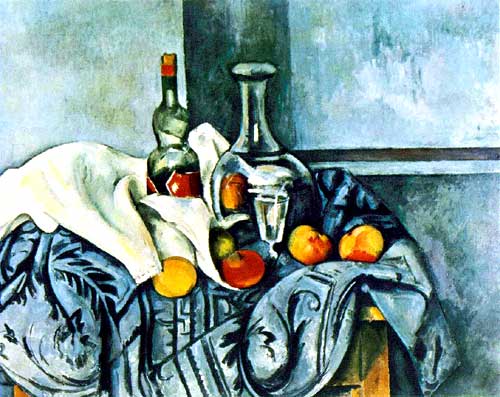| Paul Cézanne’s
Still Life with Peppermint Bottle painting seems to frame a space 4 ft. wide and 3 ft. high. Perhaps the artist is painting from about 5 ft. away. This painting isn’t aiming for precision or realism. Instead, the painting has a lazy feeling to
it - the image has soft edges, colors are smooth and oily. From the
artist's point of view, he could not have reached for the fruits, bottle, or vase from where he was painting. A few steps toward the paintings contents and perhaps he could touch the comforter.
Cézanne’s painting has a blue feeling; blue is a color that I associate with peppermint, mostly because I think peppermint is icy or
cool, and blue is the epitome of cool. Peppermint is actually associated with green, but I reason that blue is the appropriate color and represents peppermint well. To list the paintings contents will help you appreciate the following details that I use to describe the painting.
There is a aqua blue wall used as a backdrop, in the foreground, are two accessories from a bed – one is a blue comforter that seems to be thick, the other is a white sheet tucked in on the left side of the comforter that seems to be unusually thick as well. There are five oval fruits, which are in front of a clear drinking glass. The drinking glass looks like those glasses that you get at the bars when you order a pint. However, this glass is raised in the air by a stem and base, partially hidden by the comforter. The crystal drinking glass in front of the glass vase, is reflecting off the vase as well, thus making it blend into the chrome vase. The drinking glass is behind the fruits but in front of a tall glass vase with a long but proportionate neck that is fat at the bottom, curves inward in the middle, then outwards at the top. It’s roughly three times taller than the clear drinking glass. To the left of the vase, is a peppermint bottle that stands just as high as the vase, but with the cork, is taller. The lighting is good; the light seems like it is coming from the left side of the painting, making the left side of the painting brighter than the right side – the right side contains a lot of contrast between light and shadow.
The wall behind the center of focus is aqua blue with hints of green, like that of the vines that grow along the walls in Aztec ruins. There is a black line that is 3 inches wide, about chest high, crossing the painting horizontally on the wall. It intersects mid-point (in the painting) with the base of the neck on the tall glass vase. After it meets the glass vase, it disappears, no longer visible behind the comforter and sheet. The glass vase shines like it is chrome, but in the 18th century, chrome did not exist. The shape of the tall glass vase is also distorted. That is to say that it seems to be oblong and leaning towards the peppermint bottle that is the left of it in the painting.
Resting on top of the blue comforter, beneath and foregrounding the tall glass vase are five assorted citrus fruits of yellow, green, red, and orange textures; a green one is vividly reflected in the glass vase. A yellow one is separated to the left, directly below the peppermint bottle, in it’s own world by a white sheet, separate from the two pair’s of fruit that rest next to each other like brother and sister in an old photograph. Two of the citrus fruits look as they are barely maintaining their position on the blue comforter. There isn’t a distinct sharp crease in the comforter to suggest an edge of the table that the fruits are resting on. Instead, there is a slight shadow beneath each
fruit and they sit contently in place on top of the blue comforter.
Framing the paintings contents is a sky blue comforter on top of an end table. The comforter has a black floral print covering it and it seems to have a lot of volume as it sits over the end table, revealing only the corner of the top of the table where it meets the right side supporting leg. It bulges around the fruit, vase, and bottle like a valley of mountains surrounding a town. A creamy textured white sheet that is placed with wrinkles and creases on top of the blue comforter is wrapped around a Peppermint Bottle. The Peppermint bottle is perhaps the focus of the print, because of its curvaceous shape of the bottle – like that of a woman with a thin waist and wide hips. The bottle has the silhouette of a ballroom dress. There are hints of red marking the label surrounding the bottom half of the bottle and also red at the tip of the short neck, right below the cork. The cork is resting half way in the bottle; this is a half-full or half-empty bottle depending on your viewpoint. The painting doesn’t reveal any liquid to justify being half-full; a portion of the white sheet covers the bottom half of the bottle and there is a dark shadow inside the bottle, suggesting liquid. |
